Background
The Great Stop of 1672 caused five of the leading London Goldsmiths to go bust, drastically affected nine others, and ‘financially embarrassed over 10,000 wealthy families in England.
- The Great Stop effectively ended the ‘cosy relationship’ between the king and a small clique of private bankers that thrived on the Crown’s inability to generate enough cash to cover its short-term expenditure
This created a huge disruption to the development of banking in the City of London. Charles II had, via a combination of a medieval fiduciary instrument (tally sticks) and the belief that the Crown would never default on loans, had stripped the London Goldsmiths of their gold and silver in exchange for a load of worthless wood (tally sticks).
- While parliament was prorogued, the so-called Cabal (in the House of Commons and their ‘handlers’ in the House of Lords) had unwisely engineered the “Great Stop of the Exchequer” in January 1672, redirecting the revenues designated for the paying of government debt towards financing a new fleet for the upcoming war.
- This ‘Cabal’ was a group of important ministers who served Charles.
- Clifford – the Lord Treasurer and Catholic convert – wanted to see the advancement of Catholicism. Usually pro-French
- Arlington – generally pro-Dutch in terms of foreign policy but suppressed feelings to keep favour with Charles.
- Buckingham – politically inconsistent, main aim was self-aggrandisement. Generally wanted more toleration for Dissenters.
- Lord Ashley (Anthony Ashley Cooper) wanted toleration for Dissenters and was in favour of excluding James Duke of York from the succession because of his Catholicism.
- Lauderdale (John Maitland, Duke of Lauderdale) spent most of his time governing Scotland for the King.
- In fact the nickname is misleading as these ministers were not really agreed on policy and Lauderdale was rarely at Court.
- All came together in 1670 to sign the Treaty of Dover, which allied England to France (a Catholic country with an absolutist king, and traditionally the enemy of England). This caused great suspicion amongst the Protestant zealots in Parliament.
- In 1672 the Declaration of Indulgence was passed on eve of Third Dutch War
- It suspended all penal laws against Dissenters
- It offered licences to Dissenters to hold public worship.
- It allowed Catholics to worship in their own homes
- This ‘Cabal’ was a group of important ministers who served Charles.
The Third Anglo-Dutch War
- The Third Anglo-Dutch war (begun in April 1672), however, soon forced Charles II’s hand.
- The previous default (The Great Stop of 1672) prompted the goldsmith bankers of London to cease all further credit to the crown, forcing Charles II to finally call parliament again in early 1673 for its 10th Session to plead for funds.
- With the Cabal gone, Charles II relied upon Thomas Osborne, Earl of Danby (whose policies were largely Cavalier in tendency i.e. anti-Catholic and anti-French)
- Dissenters and Anglicans united in their fear of popery.
- They believed that there were thousands of papists disguised as good Anglicans.
- They were worried about popery at the highest levels of society, e.g. Charles, his mother (Henrietta Maria) and his brother the Duke of York; ministers like Clifford and Arlington.
- They were also concerned with the alliance with Catholic Louis XIV and war against Protestant Dutch
- And, they were not happy about the financial inducements Charles was receiving from the French king
- In addition to the above, Catholic Ireland was considered a likely springboard for a Catholic invasion of England
- In order to belay these fears, the Test Act of 1673 was passed.
- Dissenters and Anglicans united in their fear of popery.
- With the Cabal gone, Charles II relied upon Thomas Osborne, Earl of Danby (whose policies were largely Cavalier in tendency i.e. anti-Catholic and anti-French)
The Test Act of 1673
The passing of the first Test Act in May 1673, required all office-holders to deny Catholic ‘transubstantiation’ and take Anglican communion. It was designed to break the Cabal and/or reduce their influence. The year 1673 had seen big outburst of Anti-Catholic pamphlets and propaganda in wake of alliance with France – Louis seen as embodiment of Catholicism and ‘absolute’ rule.
- Anyone who refused to take oaths of Allegiance and Supremacy, or who refused to take the sacrament according to the rites of the Anglican Church were to lose office
- It was brought in by the Commons as reaction to renewed fear of a Popish plot.
- In addition there were widespread rumours about the conversion of the Duke of York to Catholicism
- Following the 1673 Test Act, the members of the Cabal gradually resigned or were dismissed
- Rather than submit to the Test, Clifford resigned as Treasurer, being replaced by Danby
- More significantly the king’s own brother and heir apparent, James Duke of York, also resigned.
- James’s refusal caught the public by surprise – and signaled the prospect that Charles II might be succeeded by a Catholic king.
- This (eventually) led to James II’s forced abdication and the Glorious Revolution of 1689
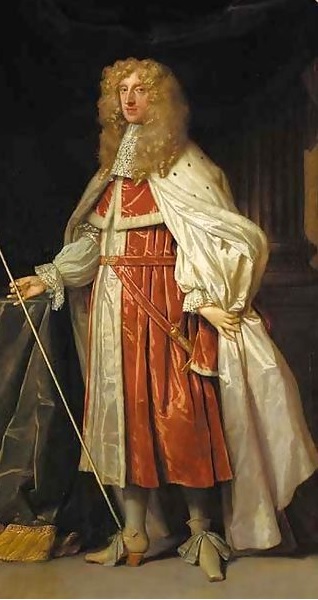
Portrait of Thomas Osborne, 1st Earl of Danby (Sir Peter Lely)
Danby came to prominence as Lord Treasurer.
- He famously said that
- “Parliament must be gratified by executing the laws both against Popery and Non-Conformity and withdrawing apparently from the French interest.”
- Orders in Council 1675 said Catholic priests to leave country, papists not to come to Court or to send children abroad to be educated.
- Anglican Church Commissioners were sent into each shire to enquire into recusants’ lands and confiscate ⅔ for the King, therefore instead of levying unpopular taxes on wealthy landowners who could avoid tax, the king received rents directly from the tenants – a far greater amount of money with increased cashflow throughout the year
- He also encouraged Charles to follow a Protestant foreign policy.
- “Parliament must be gratified by executing the laws both against Popery and Non-Conformity and withdrawing apparently from the French interest.”
Through the brief 12th Session of early 1674, Shaftesbury and his friends, flexing their new muscles, steered a slew of provocative bills in the House of Lords, e.g. expelling Catholics from London, forcing an oath that renounced the Pope, requiring royal family members to get parliamentary consent on marriage and how to raise their children.
- Finally, Shaftesbury’s clique begin considering bringing James of York on charges of high treason
- Charles II quickly prorogued the session, preventing the session’s act from being passed.
- It is thought that Charles himself may have secretly been a Catholic too.
Meanwhile, against a background of in-fighting and factions in both the House of Parliament and the House of Lords, the problem of how to solve the financing of the Third Anglo-Dutch War began to emerge. George Downing and number of other financial advisors (incl. Sir Isaac Newton, who was Master of the Mint at the time) introduced the idea of raising money by selling marketable Treasury orders with a guaranteed repayment date.
- Today, these are known as government bonds and eased the pressure a little on the Royal office for funding the Anglo-Dutch war.
- It didn’t solve the situation
Danby’s Fiscal Success
- Meanwhile, Danby’s fiscal policies significantly improved the king’s financial situation :-
- Greater commercial prosperity after late 1660’s saw rise in income from customs.
- Improved collection of hearth tax, excise tax and customs.
- By 1678 Charles income has reached c. £1.3 million from c. £900,000 in 1663.
- Peace was made with Dutch in 1674 but expenditure increased more rapidly than income.
- Government debt increased by c£750,000 in period 1674-8
- Many put this down to the generous pensions (bribes) that Danby used to maintain his working majority
- Parliamentarians were worried about papists but encouraged by Danby’s attempts to enforce laws against recusants
- By 1676 about 20-30 important MPs received ‘huge’ government pensions and could be relied upon to support government policies
- Many put this down to the generous pensions (bribes) that Danby used to maintain his working majority
- Government debt increased by c£750,000 in period 1674-8
- Danby also built up support for Crown in the shires.
- 26 shires saw JPs displaced by Danby in favour of Tories.
- By 1670 death rate amongst old Commonwealth JPs pretty high.
- They were usually replaced by Anglicans loyal to Charles.
It is thought that Charles II might have seen Catholicism as the only way to regain absolute power but in the shorter term, Danby’s policies seemed to be working towards this end. If Charles II really was a Catholic, he seems happy to have kept this a secret while Danby filled his coffers and worked towards restoring absolute rule via Anglicanism.
- Danby is thought to have favoured an increased use of the army in politics, as a way of bringing in absolutism.
- His financial and foreign policy successes, however, were tempered by the tricky situation between the Established Church (Anglican) and the dissenting Protestants and the Catholics – both of which were still powerful and wealthy elements of English society.
- The Test Act of 1673 did not cover members of House of Lords, so there was still a very wealthy Catholic elite.
The ongoing costs of Charles II’s mistresses & their children
There was also reference to the “cost” of the hedonistic court of Charles II and his many expensive mistresses. In 1667, when the crown asked parliament for the necessary £1.5m to fight the Dutch, it replied that first it wanted to know how the £5m it had previously allocated to the exchequer had been spent.
- No answer was forthcoming.
- According to Samuel Pepys at the navy board, £2.3m was unaccounted for.
- It was rumoured that the king had lavished much of this on his mistresses.
The situation after 1667 did not improve with regard to the cost of maintaining the affections of the many royal mistresses and lavish court entertainments.
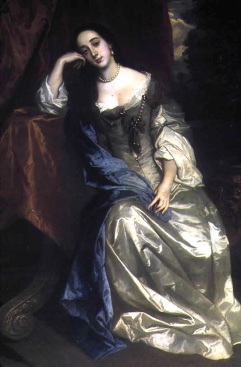
Barbara Palmer, 1st Duchess of Cleveland
- Barbara Palmer, 1st Duchess of Cleveland, Countess of Castlemaine, also known as Lady Castlemaine
- She had five children, all of whom were acknowledged and subsequently ennobled.
- Lady Anne Palmer, later FitzRoy (1661–1722), probably daughter of Charles II. She later became the Countess of Sussex.
- Charles Palmer, later FitzRoy (1662–1730), styled Lord Limerick and later Earl of Southampton, created Duke of Southampton (1675), later 2nd Duke of Cleveland (1709)
- Henry FitzRoy (1663–1690), created Earl of Euston (1672) and Duke of Grafton (1675)
- Charlotte FitzRoy (1664–1718), later Countess of Lichfield. She gave birth to twenty children.
- George FitzRoy (1665–1716), created Earl of Northumberland (1674) and Duke of Northumberland (1683)
- Barbara (Benedicta) FitzRoy (1672–1737) – Barbara Villiers claimed that she was Charles’s daughter, but she was probably the child of her mother’s second cousin and lover,John Churchill, later Duke of Marlborough
- Although their mother might have been out of favour, all of these later titles came with pensions and allowances
- Charles II (and his successors) would be paying for this out of the Privy Purse long after his departure from Barbara Palmer
- Her influence was so great that she has been referred to as “The Uncrowned Queen
- She would help herself to money from the Privy Purse and take bribes from the Spanish and the French.
- She was famously extravagant and promiscuous.
- She converted to Roman Catholicism from Anglicanism in 1663
- As the result of the 1673 Test Act, which essentially banned Catholics from holding office, Barbara lost her position as Lady of the Bedchamber, and the King cast her aside completely from her position as a mistress, taking Louise de Kéroualle as his newest “favourite” royal mistress.
- Barbara had many notable descendants, including Lady Diana Spencer, Sarah, Duchess of York, and Serena Armstrong-Jones, Viscountess Linley.
- She had five children, all of whom were acknowledged and subsequently ennobled.

Portrait of Mary (Moll) Davis
- Mary “Moll” Davis (also Davies, or Davys)
- Davis met King Charles II in a theatre or coffee-house in about 1667
- She flaunted the wealth she acquired from her association with Charles, and gained a reputation for vulgarity and greed
- Davis gave up the stage in 1668 and in 1669 had a daughter by Charles, Lady Mary Tudor
- Later, Charles dismissed Davis, possibly due to some chicanery by Nell Gwynne, a major rival for the King’s affections.
- Davis did not leave empty-handed however: Charles awarded her an annual pension for life of £1,000 p.a.
- In January, 1667–68, Pepys notes that the King had furnished a house for Moll Davis, the actress, “in Suffolke Street most richly, which is a most infinite shame.”
- In October 1673, Davis bought a new house in St James’s Square from trustees for Edward Shaw, paying £1800.
- It was demolished in 1847 to make way for a new club house for the Army and Navy Club
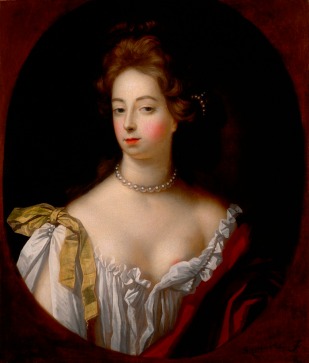
Nell Gwynn – a young East Ender from Coal Pan Alley, who sold oranges to the crowds at Drury Lane
- Nell Gwynn
- The love affair between the King and Gwyn allegedly began in April 1668
- Nell gave birth to her first son, Charles, on 8 May 1670. This was the King’s seventh son — by five separate mistresses.
- In February 1671, Nell moved into a brick townhouse at 79 Pall Mall. The property was owned by the crown and its current resident was instructed to transfer the lease to Gwyn. It would be her main residence for the rest of her life.
- Nell Gwyn gave birth to her second child by the King, christened James, on 25 December 1671
- Shortly afterwards, the King granted a house which was renamed as Burford House, on the edge of the Home Park in Windsor, to Nell and their son. She lived there when the King was in residence at Windsor Castle.
- In addition to the above, Nell also had a summer residence on the site of what is now 61-63 King’s Cross Road
- 1684, King Charles granted his son Charles, Earl of Burford, the title of Duke of St Albans, gave him an allowance of £1,000 a year, and also granted him the offices of Chief Ranger of Enfield Chase and Master of the Hawks in reversion
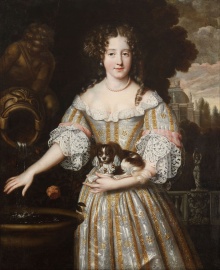
Louise de Kéroualle, Duchess of Portsmouth
- Louise de Kéroualle,
- Louise was placed early in her life in the household of Henrietta Anne Stuart, Duchess of Orléans, sister of Charles II of England, and sister-in-law of Louis XIV of France.
- Unlike her predecessor Barbara Palmer, who had openly insulted the Queen, Louise was careful to show her every respect, and relations between the two women were never less than amicable
- The titles of Baroness Petersfield, Countess of Fareham and Duchess of Portsmouth were granted to her for life on 19 August 1673
- The French court gave her frequent presents, and in December 1673 conferred upon her the fief Duchess of Aubigny in the Peerage of France at the request of Charles II – it was widely thought that she was a French spy
- In February 1685 she assisted in measures to see that Charles II was received into the Catholic Church on his deathbed.
- Her pensions and money allowances of various kinds were enormous – in 1681 alone she received £136,000
- Through her son by Charles II, Charles Lennox, 1st Duke of Richmond, she is ancestress of both wives of Prince Charles: Diana, Princess of Wales, and Camilla, Duchess of Cornwall.
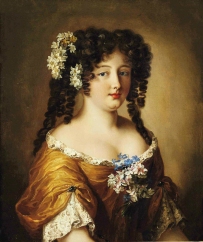
Hortense Mancini by Pierre Mignard
- Hortense Mancini, Duchesse Mazarin
- In 1675, she travelled to London under the pretext of a visit to her young niece, Mary of Modena, the new wife of Charles II’s younger brother, James, Duke of York.
- By mid-1676, Hortense had taken the place of Louise de Kerouaille in Charles’s affections.
- He provided her a pension of £4,000 per annum
The Royal Default of 1676
On February 8th 1676, Charles II once again defaulted on loans with his creditors – this time, it was a default, not a temporary stop.
- He defaulted with this speech given to his bankers :-
Gentlemen,
I have always resolved to show myself an honest man in paying my debts, and its not my fault that I cannot repay you with the same frankness you used … in lending it, but having been so honestly dealt with by you, I will pay it as well as possibly I can. And to that purpose tomorrow will pass an Order in Council for the Settling ye Interest of it, till I can pay the principall and according to your owne desires too, upon the Excise.
Consequences of the Royal Default
The financial implications of this default, combined with disagreement over foreign and religious policies, meant that the Crown and Parliament had more arguments for years to come until Parliament was dissolved in 1681 and King Charles ruled alone, i.e. he had ‘finally’ achieved absolute power – albeit at huge expense.
Obviously, the bankers in the city of London were no longer willing to loan any more money to Charles but he survived on the vast rents from Danby’s land confiscations, plus secret subsidies from the Catholic king of France in return for not siding with the enemies of France in the various conflicts of the late 17th C.
- Whereas Charles I ruled ‘by the Grace of God’, his son Charles II ruled by corruption and bribery, via the generous pensions he paid the lords (of the so-called Cavalier Parliament) and his army to support him.
- The beginnings of the Glorious Revolution in which William III (a.k.a. William of Orange) would be asked to take over lie here.
Looking back on Charles’s reign, Tories tended to view it as a time of benevolent monarchy (they received huge pensions for their continued support) whereas Whigs perceived it as a terrible despotism.
John Wilmot, 2nd Earl of Rochester (English poet, satirist and rake), wrote of Charles:
“Restless he rolls from whore to whore
A merry monarch, scandalous and poor”
Charles II is also remembered as a patron of the arts and sciences, founded the Royal Observatory and supported the Royal Society, a scientific group whose early members included Robert Hooke, Robert Boyle and Sir Isaac Newton. He was the personal patron of Sir Christopher Wren, the architect who helped rebuild London after the Great Fire and who constructed the Royal Hospital Chelsea, which Charles founded as a home for retired soldiers in 1682. His reign also included the Great Plague and the Great Fire of London – both of which required huge sums of money to re-build the city of London.









